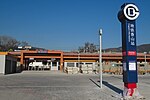Fragrant Hills
Haidian DistrictParks in Beijing

Fragrant Hills Park or Xiangshan Park (香山公园) is a public park and former imperial garden at the foot of the Western Hills in the Haidian District, Beijing, China. It was also formerly known as Jingyi Garden or "Jingyiyuan" (靜宜園). It covers 160 ha (395 acres) and consists of a natural pine-cypress forest, hills with maple trees, smoke trees and persimmon trees, as well as landscaped areas with traditional architecture and cultural relics. The name derives from the highest peak of Fragrant Hills, Xianglu Feng (Incense Burner Peak), a 557-meter (1,827 ft) hill with two large stones resembling incense burners at the top.
Excerpt from the Wikipedia article Fragrant Hills (License: CC BY-SA 3.0, Authors, Images).Fragrant Hills
枫林路, Haidian District
Geographical coordinates (GPS) Address External links Nearby Places Show on map
Geographical coordinates (GPS)
| Latitude | Longitude |
|---|---|
| N 39.990997222222 ° | E 116.17969166667 ° |
Address
香山公园
枫林路
100094 Haidian District
Beijing, China
Open on Google Maps









